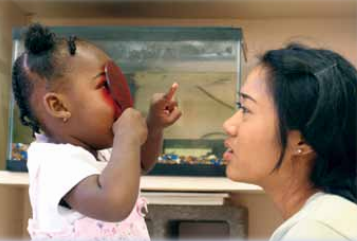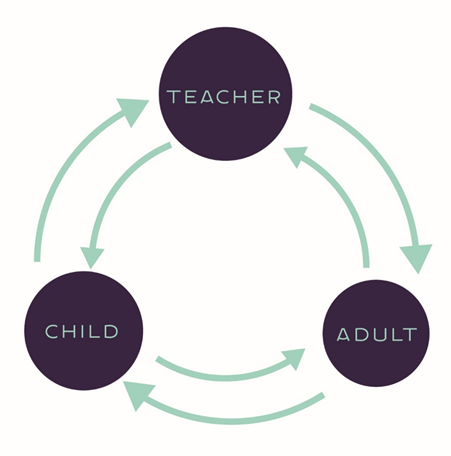2.2 Why Play?
Play:
- Inspires imagination
- Facilitates creativity
- Fosters problem solving
- Promotes development of new skills
- Builds confidence and higher levels of self-esteem
- Allows free exploration of the environment
- Fosters learning through hands-on and sensory exploration
It is now understood that moments often discounted as “just play” or as “fiddling around” are actually moments in which children are actively learning (Hirsh-Pasek et al. 2009; Jones and Reynolds 2011; Zigler, Singer, and Bishop-Josef 2004; Elkind 2007.) While engaged in play, children explore the physical properties of materials and the possibilities for action, transformation, or representation. Children try out a variety of ways to act on objects and materials and, in so doing, experiment with and build concepts and ideas. This active engagement with the world of people and objects starts from the moment of birth.
This description of the young child as an active participant in learning informs the role of the teacher who works with young children birth to five. Early childhood teaching and learning begins with teachers watching and listening to discover how infants and young children actively engage in making sense of their everyday encounters with people and objects. When teachers observe and listen with care, infants and young children reveal clues about their thinking, their feelings, or their intentions. Children’s actions, gestures, and words illuminate what they are trying to figure out or how they attempt to make sense of the attributes, actions, and responses of people and objects. Effective early childhood teaching requires teachers to recognize how infants and young children actively search for meaning, making sense of ideas and feelings.

When teaching is viewed in this light, children become active participants alongside teachers in negotiating the course of the curriculum. Families who entrust their children to the care and guidance of early childhood teachers also become active participants in this process. Shared participation by everyone in the work of creating lively encounters with learning allows a dynamic exchange of information and ideas—from child to adult, from adult to child, from adult to adult, and from child to child. The perspective of each (child, family, teacher) informs the other, and each learns from the other. Each relationship (child with family, child with teacher, child with child, and family with teacher) is reciprocal, with each participant giving and receiving from the other, and each adding to the other’s learning and understanding. [1]

The Educators’ Guide to the Framework For School Age Care In Australia discusses the benefits of play:
Play is a valued process, not only for enjoyment and leisure, but also for learning. Through play, children develop a sense of identity and an understanding of their social and cultural worlds. Children use play to explore and understand cultures, communities and friendships. We gain a lot through playing, not just as children, but also as adults.
Recent brain research has heralded the benefits of a stimulating play-based environment in encouraging the brain to grow and develop (Diamond 1988). Low stress levels and high engagement combine to nourish neural development. Research by Vandell and others (2005) demonstrates how school-aged care environments achieve this through the combination of high intrinsic motivation and challenge, effort and enjoyment. Lester and Russell (2009) identified the flexibility and plasticity of the brain, which develops through play and increases potential for learning later in life.
The intellectual and cognitive benefits of playing have been well documented. Children who engage in quality play experiences are more likely to:
- Have well developed memory skills and language development,
- Have the ability to regulate their behavior, leading to enhanced adjustment to school and academic learning.
- Play also provides children with an opportunity to just ‘be’.[2]
Pause to Reflect
What does it mean to just be? Consider a time either as a child or an adult, where you had an opportunity to just be. What facilitated the opportunity? What feelings did you experience? What might this mean for young children?
Educators observe stages of play experiences children navigate in their programs. Educators use these observations of children to plan for environments, set individual objectives and create appropriate curricular experiences.
Table 2.1: Piaget’s Stages of Play
| Stage | Description |
|---|---|
| Functional Play | Exploring, inspecting, and learning through repetitive physical activity.[6] |
| Symbolic Play | The ability to use objects, actions, or ideas to represent other objects, actions, or ideas and may include taking on roles.[5] |
| Constructive Play | Involves experimenting with objects to build things; learning things that were previously unknown with hands on manipulations of materials.[4] |
| Games with Rules | Imposes rules that must be followed by everyone that is playing; the logic and order involved forms that the foundations for developing game playing strategy.[3] |
In addition to the stages of play described by Piaget, there are also a variety of types of play children use when interacting within our ECE Programs.
- The Integrated Nature of Learning by the California Department of Education is used with permission (pg. 5); Content by Clint Springer is licensed under CC BY 4.0 ↵
- Australian Government Department of Education (n.d.) Educator My Time, Our Place. Retrieved from files.acecqa.gov.au/files/National-Quality-Framework-Resources-Kit/educators_my_time_our_place.pdf ↵
- Play and Playground Encyclopedia (n.d.) Games with Rules. Retrieved from https://www.pgpedia.cohttps://www.pgpedia.com/g/games-rulesm/g/games-rules ↵
- Play and Playground Encyclopedia (n.d.) Constructive Play. Retrieved from https://www.pgpedia.comhttps://www.pgpedia.com/c/constructive-play/c/constructive-play ↵
- Play and Playground Encyclopedia (n.d.) Symbolic Play. Retrieved from https://www.pgpedia.com/s/shttps://www.pgpedia.com/s/symbolic-playymbolic-play ↵
- Cognitive and Social Types of Play (n.d.). Retrieved from https://groundsforplay.com/https://groundsforplay.com/cognitive-and-social-forms-playcognitive-and-social-forms-play ↵
- Cognitive and Social Types of Play (n.d.). Retrieved from https://groundsforplay.com/cognitive-and-social-forms-play ↵

